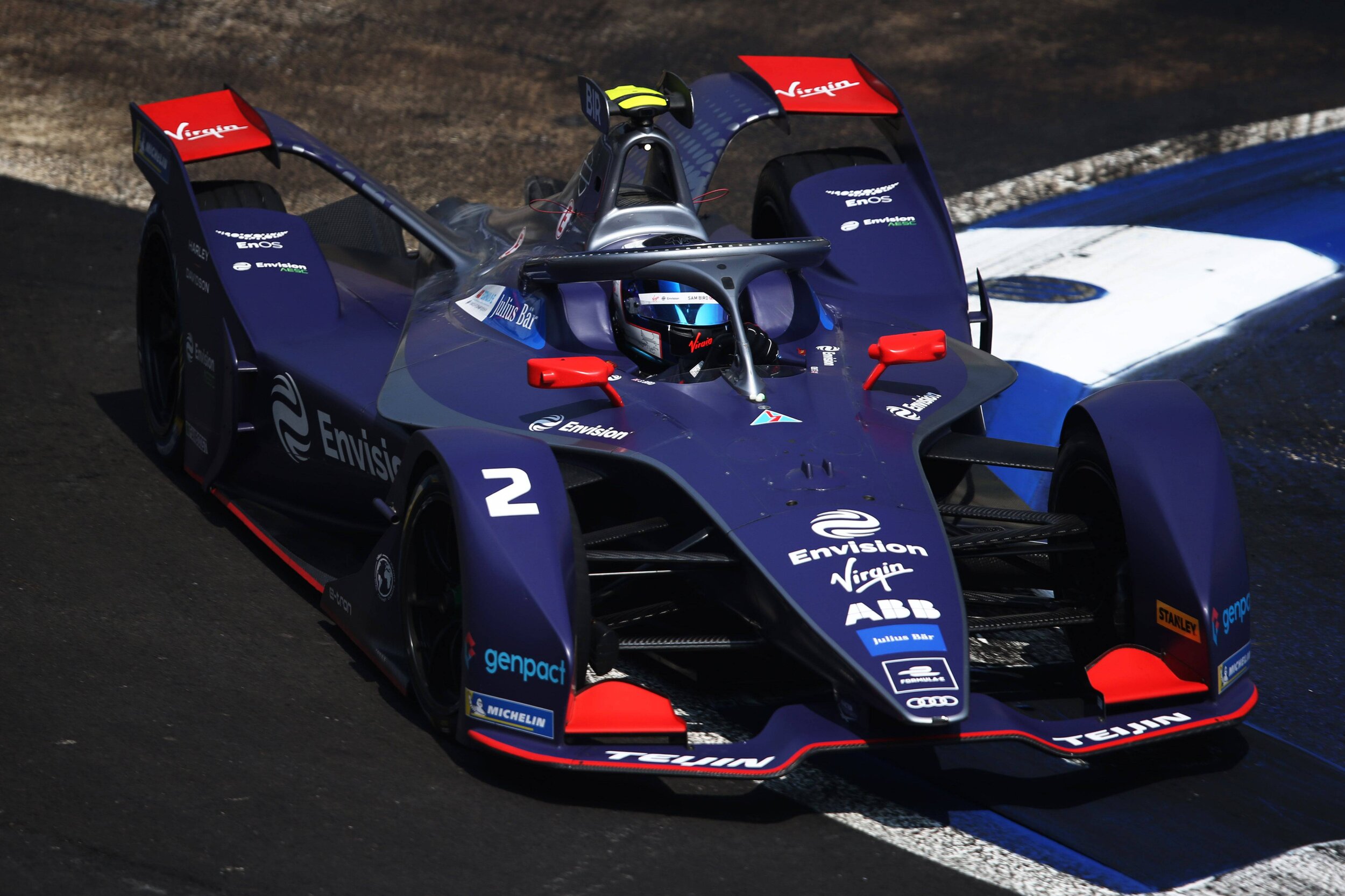Jaguar Needed This One: Formula E, Mexico City
Mitch Evans celebrates winning the Mexico City E-Prix for Jaguar Racing (photo under licence and © FIA Formula E)
This was a win that Jaguar Racing, and its parent company Jaguar Land Rover, desperately needed. You could see it in the clenched fists and jubilation in the pit garage after Mitch Evans crossed the line in the Mexico City E-Prix. Even the usually outwardly placid James Barclay was joining in the mass celebrations.
Often when you see a driver cross the line, it’s clear that members of their team view it as a job well done, but that there is a general wish not to go overboard, given that the championship is the ultimate goal. As an example, when DS Techeetah or Envision Virgin Racing take a win, the reaction of team principals Mark Preston and Silvain Filippi is usually quiet pride. For the Jaguar team, this seemed to mean so much more. There is always pressure in motorsport, particularly for a manufacturer team, and there is every chance this deserved and dominant victory gave all team members a boost they had been looking for.
Jaguar has taken major steps to be associated with electrification and to secure its long-term future, with the launch of the roadgoing I-Pace and the continuation of the I-Pace E-Trophy part of an attempt to challenge Tesla’s cachet as the cool EV manufacturer. Although I-Pace sales trebled in 2019 compared with its launch year in 2018, the luxury market is being severely compressed, and Jaguar is suffering - being a British manufacturer during Brexit another notable difficulty.
Formula E, as with any form of motorsport, is not a cheap place to be, but compared to most other series that have a similar exposire, it’s eminently affordable. What Jaguar needs is to get a pay-off from its motorsport involvement, in road car sales. Winning in Rome in Season 5 was a first step in that direction, but this win in Mexico City highlighted that Jaguar Racing now has a car that is not just an occasional cameo in the winner’s circle, but, in optimal conditions, a frontrunner to set your watch by. That cannot hurt in the dealership on a weekday.
After scraping past Lotterer at the start, Evans was dominant (photo under licence and © FIA Formula E)
Where Evans had been frustrated in Santiago, constant battery overheating issues robbing him of his early-race pace as Max Günther and Antonio Felix da Costa raced into the distance, here the forward progress was serene, as if we were watching a delicate figure-skater skimming the ice, while the galutes behind struggled to get traction from their rented skates. Evans seemed surprised in the post-race interviews at how effectively he had been able to build and manage a lead over his rivals.
Andre Lotterer had been the surprise polesitter; Porsche’s driver has been up-and-down in Formula E qualifying, but this time he got everything dialled in at the right time. When it came to the race start, it was a different matter. Lotterer, as he did in Rome, got squeezed by a faster Evans, running wide at turn one after a slow start. Neither driver is averse to applying aggression when they want to get a job done, and so any battle between the two of them is always worth watching. Perhaps unsettled by Evans’s robust move, Lotterer dropped to fifth after the new hairpin complex.
It was Sebastien Buemi in the Nissan edams who, if not taking the fight to Evans - the Nissan lacks the Jaguar’s outright pace in these conditions - was able to hold onto second, at least until the move of the race, from Sam Bird. The Envision Virgin driver has had his fair share of battles with Buemi over the years, and knew there wouldn’t be many opportunities to get past. When he did, it was in the stadium complex, and was a classic divebomb, coming from a long way back, but able to get the car under control just in time and hold the inside, giving Buemi only the option of ceding the position. It was tremendous driving from Bird, and if there were such a thing as a moral outcome in sport, it would have given him a podium finish.
Instead, Bird lost control of the car on the final lap, crashing into the wall at the same slow corner as Stoffel Vandoorne had a few moments prior. Bird said to Sam Smith of The Race, “My view right now is that this is such a big championship now, should the track really be breaking up?” and he had a point - while surface changes are, perhaps, part of the gamification and introduction of variables that drivers ought to be used to in Formula E, still it doesn’t look good when two top-line drivers fall foul of a swift loss of grip in that way.
Sam Bird pulled off the move of the race on Sebastien Buemi (photo under licence and © FIA Formula E)
Instead, for the second time, Antonio Felix da Costa took second. Again, the Portuguese will ponder that the pitwall cost him, if not the victory, certainly considerable time; he was asked to let his teammate Jean-Eric Vergne past mid-race, even though JEV had less usable energy, with the aim seemingly a slipstreaming tactic to benefit both drivers, but the result being one which benefited neither, da Costa going past again a couple of laps later.
DS Techeetah aren’t used to running equal number-one drivers, and it was clear from team radio that it is a delicate situation they are managing at present. Da Costa is now third in the championship and 23 points ahead of Vergne, but it is hard to see a let-up in the competitiveness between two drivers who both believe they should be leading the other.
Back to Evans and Jaguar: let’s not go overboard. We have had three E-Prix meetings run in three distinct climates and sets of circumstances. In each one, and in separate races of the Diriyah double-header, there have been different winners. Therefore, pronouncements of the most recent winner being a bona fide title contender are probably premature. What we can say is that Evans was in the battle until New York in a Jaguar that was further behind the absolute frontrunners than this one. Evans, when I asked him if he felt the new powertrain was an evolution or a revolution, chose the latter.
What we know is that in the hands of Evans, and in conditions where high temperatures are not the primary concern, the Jaguar is capable of winning. James Calado also showed the car’s pace, crossing the line in ninth, the top rookie, before a disqualification for power overuse. The British driver is still adapting to Formula E, seemingly finding qualifying the most challenging part of meetings - he was 19th in Mexico. In this, he has something in common with Neel Jani. The Porsche man was only able to claim 16th in qualifying, even in spite of having a clean track in Group Four.
Taking time to adapt to Formula E is not a disaster by any means. Lotterer was famously far off the pace of Jean-Eric Vergne in his early races at Techeetah, before hard work in the simulator led to a change of fortunes. It is notable, though, that these two acknowledged aces in endurance racing are needing patience when getting up to speed in the shortest form of motorsport.
For Buemi (right) and Bird, a picture tells a story after the race (photo under licence and © FIA Formula E)
Both drivers are serial winners throughout their careers, and their quality is not in doubt, but it’s a lot, being asked to master circuits with new surfaces and characteristics, and cars that, compared to what they have driven in previous years, are harder to get doing what you want them to. It gives the lie to the idea, frequently floated by people who don’t watch Formula E, that it’s simply a series for drivers who aren’t wanted by Formula One, and that it doesn’t require skills to do well in.
The Mexico City circuit is an outlier on the calendar, given it is the only permanent track the championship goes to. All the same, it shares with street circuits a track surface that varies over the course of a lap, with the new section and the double-apex hairpin proving challenging for the very best. Formula E is, at this stage, probably harder for a driver to adapt quickly to Formula E than F1, and when changing track characteristics catch out drivers as experienced as Bird, it goes some way to explaining why it is so difficult to get on the pace and stay there.
For Jaguar, this is a sign that the team is in the right place, and doing all the right things, and that’s something the boardroom will have noticed.




